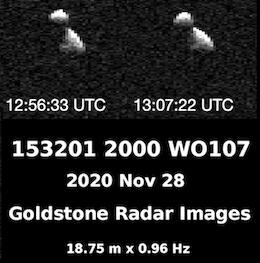Top Qs
Timeline
Chat
Perspective
(153201) 2000 WO107
Sub-kilometer asteroid From Wikipedia, the free encyclopedia
Remove ads
(153201) 2000 WO107 is a sub-kilometer asteroid, classified as near-Earth object and potentially hazardous asteroid of the Aten group with a very well determined orbit.[1] It was discovered on 29 November 2000, by astronomers of the Lincoln Near-Earth Asteroid Research (LINEAR) at the Lincoln Laboratory's Experimental Test Site near Socorro, New Mexico, in the United States.[2] It is a contact binary.[4]
Remove ads
Orbit
Summarize
Perspective
The orbit of this potentially hazardous asteroid (PHA) has been well-established with 20 years of observations. It orbits from inside the orbit of Mercury out to the orbit of Mars. It makes close approaches to all of the inner planets.[1]
2020
The asteroid came to perihelion on 13 October 2020[1] when it passed the Sun going 88 kilometers per second (320,000 kilometers per hour).[a] The asteroid was not more than 60 degrees from the Sun until 26 November 2020 and was observed by Goldstone radar on 27 November 2020.[4] On 29 November 2020 the asteroid passed 0.02876 AU (4.302 million km; 11.19 LD) from Earth.[1] Even the 2018 orbit solution had a known accuracy of roughly ±150 km for the close approach. With the radar observations the close approach distance is known with an accuracy of roughly ±5 km.
2140
This asteroid will pass 0.00162 AU (242 thousand km; 0.63 LD) from Earth on 1 December 2140.[1] The 2140 close approach distance is known with an accuracy of roughly ±1000 km. For comparison, the distance to the Moon is about 0.0026 AU (384,400 km).
The Jupiter Tisserand invariant, used to distinguish different kinds of orbits, is 6.228.[1]
History of close approaches of large near-Earth objects since 1908 (A)
Remove ads
Physical characteristics
In the SMASS classification, the object's spectral type is that of an X-type.[1][6] According to the space-based survey by NASA's NEOWISE mission, the asteroid measures 510 meters in diameter and its surface has an albedo of 0.129.[3]
Numbering and naming
This minor planet was numbered by the Minor Planet Center on 2 April 2007.[7] As of 2018, it has not been named.[2]
See also
Notes
- v = 42.1219 √1/r − 0.5/a, where r is the distance from the Sun, and a is the major semi-axis. Objects move fastest at perihelion and slowest at aphelion.
References
External links
Wikiwand - on
Seamless Wikipedia browsing. On steroids.
Remove ads

